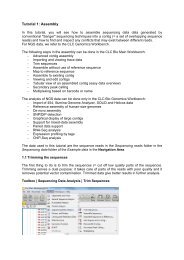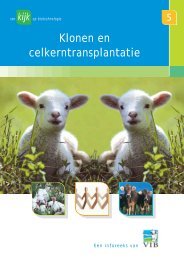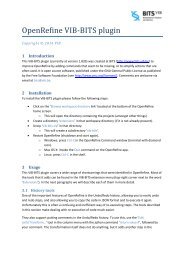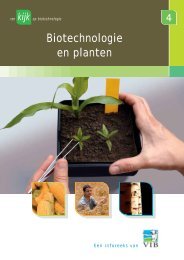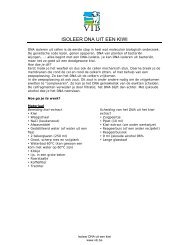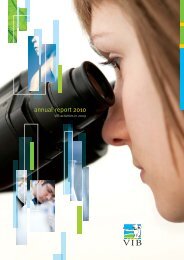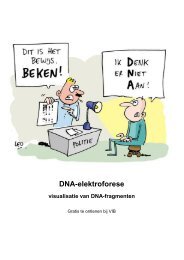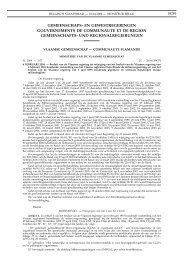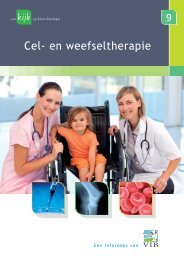Biosafety in the laboratory - VIB
Biosafety in the laboratory - VIB
Biosafety in the laboratory - VIB
You also want an ePaper? Increase the reach of your titles
YUMPU automatically turns print PDFs into web optimized ePapers that Google loves.
Work<strong>in</strong>g with genetically modified Agrobacterium<br />
Classification<br />
Most researchers work with ‘disarmed’ A. tumefaciens stra<strong>in</strong>s, which means that <strong>the</strong><br />
stra<strong>in</strong>s are no longer oncogenic. They no longer cause crown galls. These disarmed stra<strong>in</strong>s<br />
belong to risk class 1. This does not apply to wild-type stra<strong>in</strong>s or A. rhizogenes.<br />
Stra<strong>in</strong> vectors Classification* Classification Comments<br />
rule**<br />
Disarmed A. B<strong>in</strong>ary and o<strong>the</strong>r L1 1 e or j The stra<strong>in</strong>s are biologically<br />
tumefaciens plant transformation conta<strong>in</strong>ed <strong>in</strong> comparison<br />
vectors<br />
with wild-type stra<strong>in</strong>s<br />
Not disarmed A. B<strong>in</strong>ary and o<strong>the</strong>r L2 3 e or j These stra<strong>in</strong>s are pathogenic<br />
tumefaciens plant transformation<br />
vectors<br />
A. rhizogenes B<strong>in</strong>ary and o<strong>the</strong>r L2 3 e or j These stra<strong>in</strong>s are pathogenic<br />
plant transformation<br />
vectors<br />
* on <strong>the</strong> assumption that non-hazardous <strong>in</strong>serts are used<br />
** as applied <strong>in</strong> <strong>the</strong> schemes of annex 2<br />
Laboratory requirements<br />
Basic L1 conta<strong>in</strong>ment measures are sufficient for disarmed A. tumefaciens stra<strong>in</strong>s. It is<br />
enough to follow <strong>the</strong> rules laid down for E. coli K12. As far as not-disarmed tumefaciens<br />
stra<strong>in</strong>s or A. rhizogenes are concerned, basic L2 conta<strong>in</strong>ment measures will suffise. In<br />
cases when <strong>the</strong> creation and dissem<strong>in</strong>ation of aerosols conta<strong>in</strong><strong>in</strong>g <strong>the</strong> bacterium cannot be<br />
avoided, a class II safety cab<strong>in</strong>et should be used.<br />
Waste<br />
All materials, whe<strong>the</strong>r solid or fluid, should be decontam<strong>in</strong>ated, as was <strong>the</strong> case for E. coli.<br />
Sterilisation is <strong>the</strong> recommended method to this end.<br />
Note<br />
Recently transformed, little plants are often transferred onto fresh culture mediums. This<br />
activity is often performed <strong>in</strong> a cross-flow cab<strong>in</strong>et, which is permitted as long as no open<br />
sources of Agrobacterium are <strong>in</strong>volved.<br />
Work<strong>in</strong>g with commonly used <strong>laboratory</strong> organisms 43



